I am looking for a tidyverse-solution that can count occurrences of unique values of TF within groups, id in the data datatbl. When TF changes I want to count both forward and backwards from that point. This counting should be stored in a new variable PM##, so that PM## holds both plus and minus to each unique shift in TF.
This question is similar to a question I previously asked, but here I am specifically looking for a solution using tidyverse tools. Uwe provided an elegant answer to the inital question using data.table here.
If this question violates any SO policies please let me know and I'll be happy to reopen my initial question or append this an bounty-issue.
To illustrate my question with a minimal working example. I have data like this,
# install.packages(c("tidyverse"), dependencies = TRUE)
library(tibble)
tbl <- tibble(id = c(0, 0, 0, 0, 0, 0, 0, 0, 0, 0, 0, 1, 1, 1, 1,
1, 1, 1, 1, 7, 7, 7, 7, 7, 7, 7, 7, 7, 7, 7),
TF = c(NA, 0, NA, 0, 0, 1, 1, 1, NA, 0, 0, NA, 0, 0,
0, 1, 1, 1, NA, NA, 0, 0, 1, 0, 0, 1, 0, 1, 1, 1))
tbl
#> # A tibble: 30 x 2
#> id TF
#> <dbl> <dbl>
#> 1 0 NA
#> 2 0 0
#> 3 0 NA
#> 4 0 0
#> 5 0 0
#> 6 0 1
#> 7 0 1
#> 8 0 1
#> 9 0 NA
#> 10 0 0
#> # ... with 20 more rows
and this is what I am trying to obtain,
dfa <- tibble(id = c(0, 0, 0, 0, 0, 0, 0, 0, 0, 0, 0, 1, 1, 1, 1,
1, 1, 1, 1, 7, 7, 7, 7, 7, 7, 7, 7, 7, 7, 7),
TF = c(NA, 0, NA, 0, 0, 1, 1, 1, NA, 0, 0, NA, 0, 0,
0, 1, 1, 1, NA, NA, 0, 0, 1, 0, 0, 1, 0, 1, 1, 1),
PM01 = c(NA, -3, NA, -2, -1, 1, 2, 3, NA, NA, NA, NA, -3, -2, -1,
1, 2, 3, NA, NA, -2, -1, 1, NA, NA, NA, NA, NA, NA, NA),
PM02 = c(NA, NA, NA, NA, NA, -3, -2, -1, NA, 1, 2, NA, NA, NA, NA,
NA, NA, NA, NA, NA, NA, NA, -1, 1, 2, NA, NA, NA, NA, NA),
PM03 = c(NA, NA, NA, NA, NA, NA, NA, NA, NA, NA, NA, NA, NA, NA, NA,
NA, NA, NA, NA, NA, NA, NA, NA, -2, -1, 1, NA, NA, NA, NA),
PM04 = c(NA, NA, NA, NA, NA, NA, NA, NA, NA, NA, NA, NA, NA, NA, NA,
NA, NA, NA, NA, NA, NA, NA, NA, NA, NA, -1, 1, NA, NA, NA),
PM05 = c(NA, NA, NA, NA, NA, NA, NA, NA, NA, NA, NA, NA, NA, NA, NA,
NA, NA, NA, NA, NA, NA, NA, NA, NA, NA, NA, -1, 1, 2, 3)
)
dfa
#> # A tibble: 30 x 7
#> id TF PM01 PM02 PM03 PM04 PM05
#> <dbl> <dbl> <dbl> <dbl> <dbl> <dbl> <dbl>
#> 1 0 NA NA NA NA NA NA
#> 2 0 0 -3 NA NA NA NA
#> 3 0 NA NA NA NA NA NA
#> 4 0 0 -2 NA NA NA NA
#> 5 0 0 -1 NA NA NA NA
#> 6 0 1 1 -3 NA NA NA
#> 7 0 1 2 -2 NA NA NA
#> 8 0 1 3 -1 NA NA NA
#> 9 0 NA NA NA NA NA NA
#> 10 0 0 NA 1 NA NA NA
#> # ... with 20 more rows
